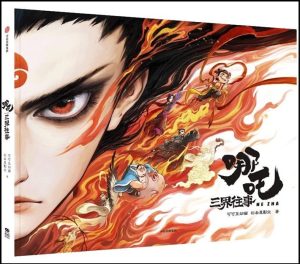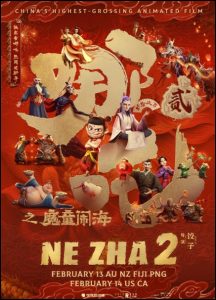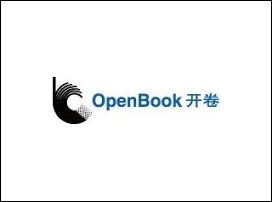
A Chinese cinema at Wanda Plaza in Guangzhou, Guangdong Province. Image – Getty: Jian Li Liu
By Porter Anderson, Editor-in-Chief | @Porter_Anderson
‘Ne Zha 2′ Blasts to No. 1’
Regular readers of our exclusive China Bestsellers are familiar with the close market pr0ximity of film, television, and books on the mainland.

‘Ne Zha 2: The Past of the Three Realms’, production poster
The latest example of this provided by our associates at Jiang Yanping‘s Beijing OpenBook might have been turbo-charged by the fact that Ne Zha: The Past of the Three Realms arrived during Spring Festival.
Directed and written by Jiaozi (Yu Yang) with Jing Wang and Wenzhang Liu producing, Ne Zha 2, as it’s called, is a an opulent animated feature, a sequel to the original film Ne Zha from 2019. (You will see some instances of the hero’s name transliterated as one word at times, in English: Nezha.)
At nearly three hours running time, the new sequel includes, as Carlos Aguilar writes at Variety, “spells, curses, vendettas, a twist villain, giant dragons who turn into humanoid warriors and many other creatures populating the world of this gargantuan feat of eye-popping computer animation.”
Eventually, a major bump in the book’s market performance might be connected to the deep level of lore-spinning that Aguilar writes may require multiple readings or viewings to understand. “Keeping up with the intricate overload of lore at hand,” he writes, “is a task that may require multiple viewings and nonstop notetaking.”
 And, of course, as new trade controversies and hostilities come into play in the decidedly non-fantasy world of current politics, there could be more to learn about how film and television rights and licensing will or won’t come into play in the question of how non-Chinese properties like this one may fare in world markets.
And, of course, as new trade controversies and hostilities come into play in the decidedly non-fantasy world of current politics, there could be more to learn about how film and television rights and licensing will or won’t come into play in the question of how non-Chinese properties like this one may fare in world markets.
The question of cultural transfer from and to the Chinese market is a vexing one. Nancy Tartaglione’s commentary at Deadline is especially good on this film’s massive success and uncertainties surrounding the international trade.
She writes, “Whether NZ2 generates newfound interest in Chinese movies outside of the home market remains to be seen. An opinion piece in the Global Times contended, ‘To truly connect with international audiences, Chinese filmmakers must find ways to make their stories more universally relatable without losing their cultural essence.”
Currently, however, China’s highest grossing animated film can be found on various platforms, and the new Ne Zha book from CITIC Publishing House has made a spectacular flight to the very top of the mainland February charts.
Below, then, are OpenBook’s overall lists from February 2025 of bestsellers in fiction, nonfiction, and children’s books, followed by its lists of bestselling fiction and nonfiction in China by authors from outside the country.
At the end of our article, as always, you’ll find notes on how the lists are constructed.
OpenBook’s Fiction Bestsellers, February 2025
OpenBook’s Nonfiction Bestsellers, February 2025
OpenBook’s Children’s Bestsellers, February 2025
Foreign Author Fiction Bestsellers, February 2025
Foreign Author Nonfiction Bestsellers, February 2025
Notes on the Charts
OpenBook is a privately owned industry-data research firm based in Beijing. It functions somewhat as Nielsen and NDP do from the West, and Nielsen Book Research International has worked with OpenBook in Asian operations. With authoritative data and information resources, OpenBook is able to deliver consulting service to partners who would like to explore the Chinese book market and identify suitable partners.
is a privately owned industry-data research firm based in Beijing. It functions somewhat as Nielsen and NDP do from the West, and Nielsen Book Research International has worked with OpenBook in Asian operations. With authoritative data and information resources, OpenBook is able to deliver consulting service to partners who would like to explore the Chinese book market and identify suitable partners.
At last report, OpenBook monitored more than 18,000 online and offline bookstores.
The online channel includes digital retailers such as large self-operated online stores, platform stores, and small- and medium-sized stores. The offline channels include more than 4,800 bookstores. Coverage includes most of the state-owned and influential privately owned bookstores in 30 provinces, municipalities, and autonomous regions. Taiwan, Hong Kong, and Tibet are not included in OpenBook’s system.
In 2022, OpenBook tracked around 76.21 billion RMB in sales (US$10.62 billion).
Retail outlets include:
- Traditional bookstores
- Supermarkets
- Campus bookstores
- “Professional” stores, said to be small stores with a specific industrial or trade focus
- Airport stores
In addition, OpenBook is drawing data from online bookstores of three main types:
- The “Tmall” stores of Alibaba (Tmall is described as a marketplace of companies that create storefronts online to sell products including books)
- The “JingDong” Stores of JD.com (similar to Tmall as a marketplace of both individual companies and bookstores operated by JD.com)
- Ten independent online bookselling retailers
China has 500 or more publishers in operation today. Most of them are government-owned. Private publishers are required to generate ISBNs for their titles from a publishing company that is government-owned—which, in other words, creates a system in which all ISBNs are registered through government channels. The government approves each book published in China.
More China bestseller reports from Publishing Perspectives are here, more on the Chinese book publishing market is here, and more on book publishing in Asia is here.
About the AuthorPorter Anderson Facebook Twitter
